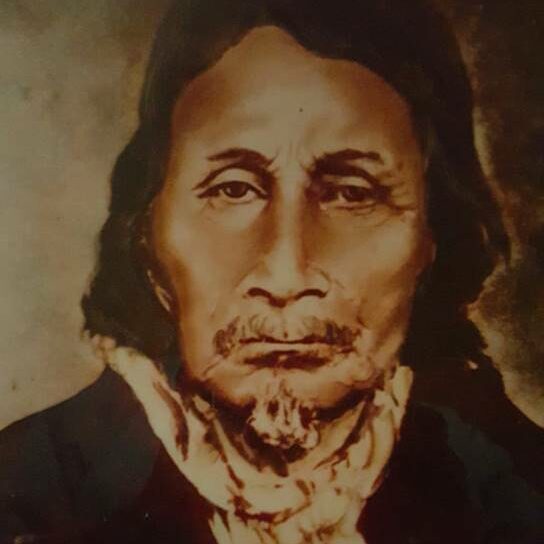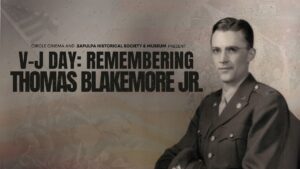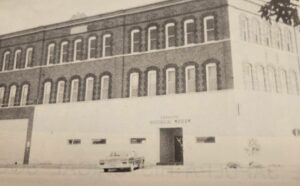Rachel Whitney, Curator,
Sapulpa Historical Museum
The township of Sapulpa would be incorporated as a city in Indian Territory (I.T.), later state of Oklahoma, on March 31, 1898 – 125 years ago, this week in Sapulpa history. But the story of Sapulpa, the person the township was named after, began long before the city establishment*.

*Note: the information about his family, tribe, parents, and life were found in interviews: a written biography published in 1926, and two transcripts of an oral interview, in 1937, from William Sapulpa and Sarah (Sapulpa) Fife, two of his children. Additional information outside these interviews has been included, too, to provide multiple perspectives.
What is Known of His Childhood
Born between 1812 and 1824*, he was born in the Muscogee (Creek) Tribe. He was raised in the area where the states of Georgia and Alabama would be established. His parents, both full-blood Muscogee (Creek), were of the Kashita Tribe. His father’s name was Omiya, translated as “the swimmer,” and his mother’s name is unknown.
*Note: in the transcript of the interview 1937, William says his father was born about 1812 or 1814, in Alabama.
“Both his parents died in Alabama when he was two or three years old. He and his three sisters were raised by his two uncles, brothers of his father.” There is no further information on his siblings and his family members.
“His boyhood and early youth were spent on the hunting grounds of their [Muscogee] country, which extended from Florida to Mississippi.” He would spend most of his childhood in this area.
Life Before Trading Post at Polecat Creek
From 1830 to the 1850s, tribal communities were forced to relocate to designations deemed “Indian Territory,” and this era was known as Trail of Tears. Tens of thousands of Indigenous Peoples were displaced. Very few Native Americans remained in their cultural areas.
“The encroachment of white settlers into that country brought him into conflict with the governmental authorities and the soldiers…The [Native Americans] proceeded to retake such of their stock as they could find, and, perhaps, taking other stock in place of the stock not found. This conduct on the part of the white settlers so aroused the manly and racial instincts of [my] young [father] to action that brought the soldiers in pursuit of him; but he was too wily and fleet of foot for the soldier boys, so they never caught him.”
“One incident of his experience with the soldiers that he often told his children was this: while out hunting with some other men, in Florida, they saw soldiers with bloodhounds-and the pursuit was on. [They] ran into a swamp…he saw a big alligator in the creek…he made a desperate jump over the alligator and the creek. But the hounds and soldiers were not so fortunate…the alligator put up such a hard fight that they [the soldiers] gave up the chase.”
William Sapulpa stated that trading with the settlers and Muscogee Creeks took place at St Augustine, Florida. He said his father would often trade here, and would learn trade and establish relationships with merchants and customers.
“His last trip to St Augustine was his last trip from the old hunting grounds…some of his white friends induced him to go with them to Charleston, SC. The trip was made by boat, and [he] was treated to sights of whales, etc. to be seen in the briny deep. Leaving Charleston, he continued by boat to New Orleans and then continued on to what later became the eastern part of the Creek Nation, in what is now Oklahoma-thus becoming one of its pioneers and one of the leaders of his people.”
It is uncertain when he arrived in the area known as Polecat Creek; sometime after 1836 and 1850, William Sapulpa suggested*.
*Note: in the transcript, William stated the area was “a good hunting and fishing region.”
Trading Post and Civil War
“Moving to what is now Creek County, he built his home, and commenced farming on Rock Creek, one mile southeast of [town of Sapulpa]. Sometime later, in about 1850, he started a store at his home, where he sold coffee, sugar, tobacco, dry goods, flour, spices, and other articles…hauling his goods in by team and pack horses from Ft Smith…”
William Sapulpa discussed how the nearest store to his father’s location was in Muskogee at the Council Hill. “At the end of two years, he gave up merchandising on account of the difficulties of getting his goods…we had no railroads, no automobiles, no trucks, no interurban lines, no bridges over our streams-and no wagon roads fit to travel.*”
*Note: in the transcript of William’s it said, the store was located in their house, which was “a large double log house.” Sarah’s transcript stated, she was born in the family’s “three log cabins, one being used for a place to cook and eat, and the other two were used as sleeping quarters…the shingles were made from large logs…their floors were made by using straight logs and splitting them to desired thickness. These made a rough floor.”
William Sapulpa remembers that there was one store and blacksmith shop “at the end of what is now South Maple Street for several years before the Civil War, and that business was kept up there until the war broke out, and that during the war all the buildings were burned.”
From 1861 to 1865, the American Civil War divided the country. The statuses of the states were divided between slave-states, union-states, border-states, and territories. The Indigenous People were also divided between fighting the conflict with the union-, slave-states, or avoiding each opposing side; but the territories were also being claimed by each side.
William Sapulpa stated: “‘I was just a little lad when the Civil War started [born in 1861], and I did not realize just what was going on…I did not know until late in life that my father was one of those fellows called the wealthy kind. He was owner of many Slaves, so naturally, he had to fight for his property, like the people of the south did.*’”
*Note: there are no other written records found, thus far, that he owned enslaved people or how many.
“When the Civil War broke out, [my father] loaned $1,000 in gold to the Confederate cause, receiving a note as evidence thereof…He joined the Creek Regiment of the Confederate Army, which he served for three years and rose to the rank of First Lieutenant, and was wounded in the Battle of Elk Creek, near what is now Checotah, OK.”
He was discharged on July 1, 1864. According to his discharge paper, he was “born in the state of Alabama, age 40 years, five feet, eight inches high, dark complexion, black eyes, black hair, and a farmer by occupation.*”
*Note: according to the discharge paper, if he was 40 in 1864, then he would presumably have been born in 1824, not 1812 or 1814, like William Sapulpa stated earlier.
“In 1872, he opened another store at his home on the hill southeast of [town], buying and hauling his merchandise this time from Coffeyville, KS. But about a year later, he closed out the business again. However, he had taken a deep interest in farming and stock raising.” William Sapulpa said his father had other hobbies, too. He was “fond of the [American] Indian ball game, and was considered the best all-round ball player on the Arkansas River.”
Wives, Children, and Religion
William Sapulpa said his father married NaKitty before moving to what would be known as Creek County. “Three children were born of this marriage: James, Hanna, and Sarah.” At the time of the written biography in 1926, William said James and Sarah were living; James lived one mile south of town, and Sarah lived within city limits*.
*Note: he had seven children with NaKitty: unknown, James, Hanna, John, Sarah, Lucy, and unknown.
It is not known if the second marriage was at the same time as NaKitty or after, however. He married again to “Cho-pok-sa*, a sister of his first wife, by whom he had seven children: Moses, Yarna, Samuel, William, Rhoda, Becca, and Nicey.” William Sapulpa said his siblings were now gone by the time of the publication in 1926. He lived “about two miles west of town.”
*Note: William Sapulpa said in the transcript of the 1937 interview that his mother’s name was “Mary in English.”
Sarah said in her transcript that “the girls of the family did not go to school-only boys. William went to Wealaka Mission and Jim (James) went to Choctaw Nation. She did not know where the others went.”
Everyone worked on the ranch. “The land was open range, no fences being there then. [We] raised cattle, horses, and hogs, raised sweet potatoes, white corn, and wheat.”
“In about 1875, he joined the Methodist Church South, and was an active member thereof from then until time of his death. He donated liberally with cattle, flour, coffee, and sugar to feed the people at Camp Meetings.”
It is often said that he had three wives and at least 10 to 14 children. His first wife did not have children with him; it was said that her name was Tenofe. He then married NaKitty. He then married Cho-pok-sa, a presumed sister of the “first wife,” often referred to as NaKitty.
Railroad Charges into Town
“In about 1884 or 1885, the Frisco railroad completed the extension from Tulsa to Sapulpa. He was invited by the Frisco officials to ride into Sapulpa on the first passenger train from Tulsa.”
Sarah recalled the biggest change that was on her mind when more and more settlers came to the area. She states, “there were no mice or rats here until after the white people settled here.”
A similar story about the railroad arriving into town stated:
“The railroad line was extended to Sapulpa in 1883 for freighting out the walnut logs found on the banks of Rock Creek. In 1886, the first passenger train came down. His son, William, took his father over to Tulsa at the invitation of the Frisco officials to ride on the first passenger train into Sapulpa. He was given two brass spittoons from that train.”
Titles and Name
“He was a member of the Coon Clan and his wives were members of the Fox Clan. He was a member of Osocheetown. In 1868, he was elected by his town as a member of the House of Kings. The position of honor and trust was held until his death on March 17, 1887.*”
*Note: other articles mention his title was House of Warriors, in addition, his grave marker states he was 75 at the time of his death. Therefore, he would have been born in 1812.
As for the term “chief,” articles and references to the town’s founder are rarely used to describe him in the early newspapers. “As always noted when biographies of Sapulpa are written, Sapulpa was not actually a ‘chief’ of his tribe, but did have a place of influence.”
Based on the transcript from Joseph Bruner in 1937, he referred to the person the town to be named after as “‘old Sapulpa’.’” Incidentally, Elizabeth (Barnett) Sapulpa referred to her father-in-law as “‘the old man.’”
Lincoln Postoak, of Red Fork, added in his transcript in 1937, that he knew the history of the person the city of Sapulpa was named for. He stated: “James Sapulpa, for whom the town of Sapulpa is named…was born in Alabama. His father’s name was Omiya; his mother’s name is not known.” Postoak continues the history of this “James Sapulpa” as the same story that William Sapulpa described above.
However, Elizabeth (Barnett) Sapulpa married to James Sapulpa, the son, stated in an article published in 1946, “And So They Called it Sapulpa,” states:
“The name ‘Sapulpa’ came about quite by accident. ‘The old man…had only one name, and that was ‘Sepulchre.’ She explained that in the olden times the [Natives] were generally given names at birth to signify some event or happening. The religious groups sought names for their children in the Bible. Something in the passage in St Matthew, after saying that Joseph claimed the body of Jesus and placed it in his own tomb, where it reads: ‘And he rolled a great stone to the door of the sepulchre,’ caught the fancy of the parents of the original ‘Sepulchre’ and they gave him that name to stand for strength.”
The article later stated that when her father-in-law sounded out his name, it may have sounded like “‘Suh-bul-ba.’” Furthermore, “the first signs of a change in ‘Sepulcher’s’ name showed on a discharge certificate from the Confederate Army: ‘it is written like the army clerk heard it, ‘Suspulber’ (Sus-pul-ber).*”
*Note: Harrison Sapulpa, a grandson, “rejected the theory of “‘Sepulcher.’”
It was often thought that the term “Sapulpa” would translate to sweet potato stated an article in 1990. But “there is no truth to the belief.” Similarly to the translation above, Sapulpa or “Sapulka, [or Sapulpakah], means burial place,” as Harrison Sapulpa explained. Another translation belief was published in a 1998 article: “‘Sapulpa’ in the Creek language means hiding spot or hide yourself, a reference to a skillful hunter.”
Merle Sapulpa, great-grandson of Sapulpa, visited the museum months before his death in 2021. Merle gave the museum workers the name “Ah ha Lark Yahola*” for his great-grandfather. Merle further discussed how in his own research, the name “Sapulpa” was never a Native American term, nor an English word or phrase. Merle suggested that the name came from railroad workers, most likely Italian workers, and he suggested “Sapulpa” could have been an Italian word or phrase given to the man who owned a trading post near the Polecat and Rock Creeks.
*Note: this name was also used in a 2005 article from Owen Sapulpa, a great-grandson. In the article he stated the name means ‘sweet potato.’ He further stated that the Muscogee term for “hole” (a hunter’s hiding hole “which would hide the human’s odor from the animals being hunted”) sounded like the term “Sapulpa” or “Sus-pul-ber.”
Grave Marker and Cemetery
He is buried in the Sapulpa Family Cemetery, located on S Division St, off E Taft Ave, at 909 S Division. The location is just past E Hastain Ave; on S Division, it’s on the eastside of the street.
“The Nancy Green Chapter, National Society Daughters of the American Revolution (NSDAR or DAR), was organized February 24, 1913, and chartered January 10, 1914.” The DAR began the care for the cemetery in January 1923. “At that time the markers were scattered over about 40 acres. Effort was made through family contacts to establish exactly where each belonged.”
The grave maker reads: “Sapulpa, died Mar. 17 1887, aged 75 years,” on front side, whereas another side written Muscogee (Creek) that translates to “he has left this old world,” or “he is leaving this world for heaven.”










